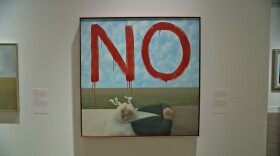Companion viewing
Bugs Bunny "What's Opera Doc?" (1957) and "Long-Haired Hare" (1949)
"The Magic Flute" (1975)
"Don Giovanni" (1979)
"Amadeus" (1984)
Wolfgang Amadeus Mozart’s "The Marriage of Figaro" is a comic opera with some serious overtones. It has also inspired both revolution and Bugs Bunny.
For some people, Bugs Bunny was the gateway drug into opera.
"Well, I think it’s a good thing," director Stephen Lawless said with a laugh. "When I started listening to opera I didn’t realize that there was a lot of opera music I knew partly because of Bugs Bunny. So I think any exposure to it is really good."
Lawless is directing "The Marriage of Figaro" at San Diego Opera, which features bass-baritone Evan Hughes in the role of Figaro.
And Hughes agreed, "The Bugs Bunny version (of 'Figaro') is wonderful."
But Hughes can trace his first exposure to Mozart’s opera to in utero since his mother sang the role of Susana while pregnant. Perhaps that’s why Hughes has a particular affection for Mozart and "The Marriage of Figaro."
"It has this incredible human element, and 'The Marriage of Figaro' is kind of a dramady and so while it is masquerading as a comedy it is really about intensely human things, real things, and quite dramatic things underneath and the music reflects that as well so it has lightheartedness as well as great depth and humanity," Hughes said.
It also ignited a political spark.
"'Figaro' is a very important piece in opera because it was considered, the play by Beaumarchais and subsequently the opera by Mozart, was considered a catalyst for the French Revolution," Hughes added.
Lawless points out that Napoleon famously described Beaumarchais’ play as “the revolution in action.”
"And that’s what it is, it’s about the attack on privilege in 18th century Spain, where it’s set, but in principle, it’s about the attack on privilege in France and it’s fairly clear that it’s an attack on privilege," Lawless said.
The opera carries the same message as it depicts the working class overcoming the oppression of the aristocracy.
"So Figaro represents that working class," Hughes said of his character. "He represents that normal human being who is being pressed down and who rises up through his intellect, through his humanity. So he wins through his wit and through his heart rather than through his money and his power."
Lawless pointed out that you could measure the opera’s impact by looking to ticket sales after it initially opened in 1786.
"Mozart’s subscription concerts were full of aristocrats who paid for the privilege. After 'The Marriage of Figaro' he didn’t have any aristocrats. So it clearly hit home and that’s pretty major," Lawless said.
Bringing the opera to the stage for a modern audience meant blowing out some of the clichés often present in productions in order to highlight its virtues.
"Because it has everything," Lawless said. "It’s funny, it’s serious, it has the potential for tragedy, it’s political so it and it’s just brilliantly written, there’s just nothing else like it. It’s like a great play being performed with the greatest soundtrack in the world."
That soundtrack was unexpectedly enhanced by set.
Lawless described what happened when rehearsals moved into the Civic Theater with the full set in place: "When we started in here I turned to the sound guy and asked, ‘Do you have sound enhancement? Because it sounds great.’ He said, 'No, no, it’s the walls.' The walls bounce the sound back into the audience in the auditorium, which is fantastic.”

Plus the set looks amazing. As the play opens the walls fill the entire stage with a looming family tree. But as the story progresses the walls move, rotate and reveal a series of doors that are perfect for conveying all the deceptions and entanglements that unfold during the course of the evening.
San Diego Opera's technical director and head carpenter John David Peters said, "It’s a complicated piece. It’s kind of deceiving because it doesn’t look like it is. You look at it and it’s two simple units that change around and do a few different positions but there are, I counted them, there are actually 50 doors built into the set so if you take the permutations of 50 it’s a mind-boggling number of the things that can be done with the doors, and then the units themselves have like eight different positions."
Peters' wife, Mary Yankee Peters, a former opera singer, now serves as San Diego Opera's stage manager, which means she calls all of the cues.
"So whenever you see any scenery moving or lights changing, I don't do anything, it's just that nobody else does anything till I say the word, 'Go.' So that's what it means calling cues for the show."
Mary said being married helps because "we solve so many problems at home. I don't understand being able to leave your work and not take it home with you."
But they won't be taking those problems home for much longer. The couple plans to retire and feel that "The Marriage of Figaro" is a good opera to make as their final one. As Mary's stopwatch ticks down, she informed me that we were now 16 minutes into a 20-minute break, and I needed to leave so she could get the musicians back in the pit for the second act.
Singer Evan Hughes noted that the challenges for him are keeping the dramatic intensity high and his voice warmed up in between acts since the bulk of the stage time for Figaro comes at the beginning and then at the end. But he noted that it's a rewarding opera to work in.
"When you find yourself inside of one of these ensembles where all of the characters are singing together and you can feel the magic of Mozart and (Lorenzo) Da Ponte coursing through your veins in this very beautiful human music there’s nothing that’s better as an artist," Hughes said.
And it's an opera that continues to delight audiences.
"Mozart said that after the premiere he walked down the street and all that he could hear were people whistling the tunes from 'The Marriage of Figaro,' that is the way it should be then or now," Lawless added.
Check out the new production of "The Marriage of Figaro" at San Diego Opera and see if it sparks a revolution or just has you humming a few bars as you leave the theater.
San Diego Opera’s production of "The Marriage of Figaro" has four performances at the Civic Theater beginning this Saturday.







